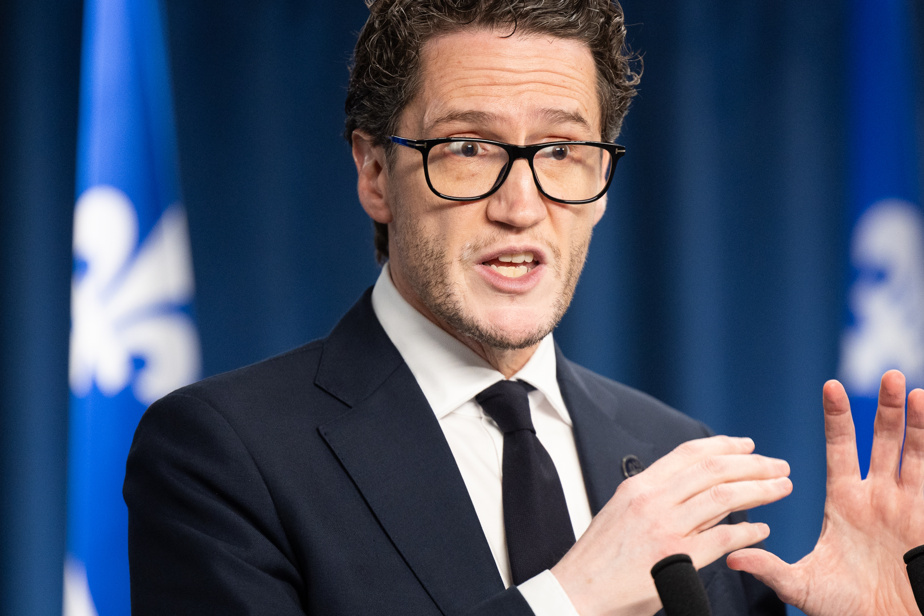The Legault government is banking on energy sobriety and efficiency to reduce Quebec’s greenhouse gas (GHG) emissions, but the reduction target of 37.5% by 2030 is still far from being reached. the drop being only 7% to date.
Improvement of existing energy saving programs, increased energy efficiency requirements for buildings and appliances, rating of the energy performance of buildings; Quebec is increasing its investments in this area to $900 million, indicates the annual update of Quebec’s action plan to combat climate change, unveiled Tuesday.
This “Implementation Plan for the 2030 Green Economy Plan” is being enhanced this year by $1 billion, increasing the total envelope to $10 billion over five years, the Minister of the Environment, Fight against climate change, Wildlife and Parks, Benoit Charette.
Quebec plans to double the annual energy savings attributable to energy sobriety and efficiency measures, increasing them from 1 terawatt hour (TWh) to 2 TWh, for a total potential reduction by 2035 of 21 TWh, which is equivalent to the annual consumption of 1.2 million households.
It is something to produce more energy, but even more profitable to reduce our consumption, making it more efficient.
Benoit Charette
The document also discusses ways to reduce household energy consumption, such as replacing the use of the car with cycling or reducing the heating temperature by one degree in winter.
“These are not necessarily sacrifices that are imposed,” specifies Minister Charette. Yes there are behavioral changes that will be necessary, […], but in many cases it saves energy that is otherwise wasted. »
Far from the count
Two thirds (67%) of the measures making it possible to achieve Quebec’s GHG emissions reduction target of 37.5% below their 1990 level by 2030 are now identified, compared to 42% in the first version of the plan. .
But Quebec has only reduced its emissions by 7% since 1990, which still places it far from the mark, just over five years from the deadline.
The lag between the adoption of reduction measures and their effect is “normal”, assured a senior official who could not be quoted, in a briefing intended for the media, giving the example of the ban on heating appliances fuel oil, which is progressing at the rate of replacements, or the gradual introduction of electric vehicles on the roads.
The Legault government is being urged on all sides to use the $1.7 billion surplus from the Electrification and Climate Change Fund, formerly known as the Green Fund, to put in place more measures to combat climate change. climate change, but it still refuses, claiming to lack green energy to accelerate the pace.
“If we had greater energy capacity at this time, we would be able to develop more measures,” declared Minister Charette. It’s not all about money. »
1.2 billion for adaptation
The update of the Quebec action plan also adds nearly 370 million additional funds for adaptation to climate change, bringing to 1.23 billion dollars the financing of measures to deal with climate upheavals.
Of this sum, 342 million will be used to implement adaptation solutions to floods and 120 million for projects to mitigate the risks of coastal erosion and submersion.
Assistance for businesses to adapt to climate change is also increased by 24 million.
The government is injecting more money into the agricultural and food sectors, which are among the most affected by climate change.
“We are providing assistance so that they can better anticipate climate change,” says Minister Charette.
Quebec will inject an additional $20 million to assess the risks that could disrupt the industry in the coming years, with the aim of better understanding future agricultural realities in order to support producers in their adaptation.
This sum is in addition to the 62 million already announced for agricultural businesses to adopt practices and technologies to reduce their emissions.
GHG emissions from agriculture have been increasing since 1990; the sector alone released 10.4% of Quebec’s emissions in 2021, or 8.1 megatons.
Reduction in this industry “represents a particularly great challenge since it will require major innovations to achieve convincing results,” maintains the Ministry.
They said
We are once again missing the opportunity to chart a clear and quantified path towards the 2030 target, then towards carbon neutrality for each sector of the economy.
Andréanne Brazeau, senior policy analyst at the David Suzuki Foundation.
The monitoring presented today by Quebec is “very disappointing”, according to Jean-Pierre Finet, analyst at the Regroupement des organisms Environnemental en Énergie. The reduction target of 37.5% is, from the start, “much too low”, he believes.
Équiterre welcomes the amounts that the government allocates to energy sobriety, which must “however be well defined”, for example with regard to the number and size of vehicles, its director of government relations wrote on the X network , Marc-André Viau.
It is deplorable to see that the government refuses to use the approximately 1.7 billion dollars lying dormant in the coffers of the Green Fund [et qui] should instead serve to accelerate the climate fight.
Patrick Bonin, head of the Climate-Energy campaign at Greenpeace Canada
Nature Québec, for its part, believes that the government must focus more on the restoration of ecosystems. “We need to invest much more to make greater use of our best climate ally: nature,” says Alice-Anne Simard, general director of the organization.
Learn more
-
- 79.1 megatons
- Quebec GHG emissions in 2022 (estimate)
source: Ministry of the Environment, the Fight against Climate Change, Wildlife and Parks.
- 25.8 megatons
- reduction in GHG emissions necessary to achieve the 2030 reduction target
source: Ministry of the Environment, the Fight against Climate Change, Wildlife and Parks.
-
- 20.7 megatons
- expected reduction in GHG emissions attributable to government measures
source: Ministry of the Environment, the Fight against Climate Change, Wildlife and Parks.
